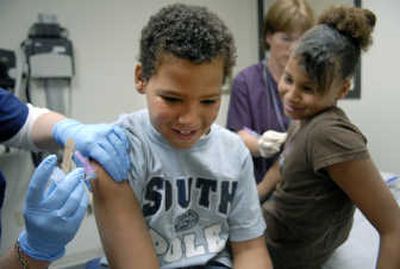CHAS grants children immunity

Sharon Leavitt’s four children are fully immunized – and the Spokane mother has the papers to prove it.
When she showed up last week at a free clinic sponsored by CHAS, the Community Health Association of Spokane, Leavitt, 35, was among a minority of parents who could document that their children are protected against disease.
“I know if they don’t get their shots they could get sick,” said Leavitt, who has been a client of the low-income medical clinic for years. “It could cause death, even.”
So she brought Candice, 17, Mercedes, 11, Robert, 10, and Tyron, 7, in for the next round of vaccinations to prevent hepatitis B as well as diphtheria, tetanus and polio.
But for every parent like Leavitt, a Spokane Community College student who hopes to go into medical billing, there are many more CHAS clients who don’t recognize the need for immunizations, clinic organizers said.
“The non-insured patients, they don’t come to the doctor unless it’s an emergency,” said Susan Chandler, immunization specialist at the clinic that treats about 6,900 Spokane children. “There are large groups of people who don’t understand that you’re supposed to come in for routine care.”
In the past, that has meant the children treated at CHAS were far less likely than other kids in Spokane – and across Washington – to be fully immunized.
This year, thanks to a $75,000 grant from the Community Health Plan of Washington, CHAS has begun boosting the rates, doubling the percentage of immunized 2-year-olds, quadrupling the percentage of 6-year-olds and even tripling the percentage of hard-to-reach 13-year-olds who are caught up.
But as the new school year starts, Chandler and other CHAS workers hope to increase those numbers even more in families where routine medical care is a luxury.
The need to get children completely vaccinated is clear, said Michele Roberts, a spokeswoman for the immunization program of the state Department of Health. Protection against life-threatening diseases such as measles, polio, pertussis and chicken pox, is achieved only through a full series of immunizations.
“A lot of kids have one here and another there,” Roberts said. “The goal is to get kids fully immunized.”
One problem is communicating that need to parents, especially in Washington, a state with generous exemption laws. In Washington, parents can opt out of vaccination with a signature verifying religious, medical or philosophical objections.
Another problem is inspiring parents to act on the need, Chandler said.
“The biggest challenge is getting them in,” she said.
When she was hired in February, Chandler was charged with reaching out to parents. She’s done so through fliers, posters, personal contacts and free clinics like the one that attracted Leavitt and more than 40 other parents.
In addition, Chandler has started asking CHAS doctors to turn even emergency visits into opportunities for vaccination.
“We still treat them for what they came in for, but when they come in for an acute care visit, we’re also giving them the immunizations,” she said.
So far, the effort has paid off. Last year, only 18 percent of CHAS 2-year-olds were fully immunized, compared with 44 percent this year. The percent of immunized 6-year-olds jumped from 13 percent to 61 percent. And the percentage of vaccinated 13-year-olds rose from 6 percent to 19 percent.
“Those are amazing numbers in less than a year,” Roberts said.
Still, CHAS clients have a long way to go. About 61 percent of all Community Health Plan children are fully immunized, according to the most recent figures from HEDIS, the Health Plan Employers Data and Information Set compiled for national quality comparison.
In Washington, 71 percent of children ages 19 months to 35 months who have had all their vaccinations, according to new figures from the National Immunization Survey conducted by the federal Centers for Disease Control and Prevention.
And it’s less than the 77 percent of children who are vaccinated nationwide, according to CDC statistics.
“Our goal is for us to be at 90 percent by June of 2008,” said Chandler, who’s already thinking about new ways to reach parents.
“You know, we’re getting there.”